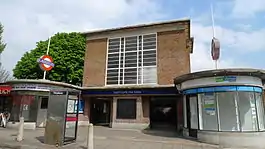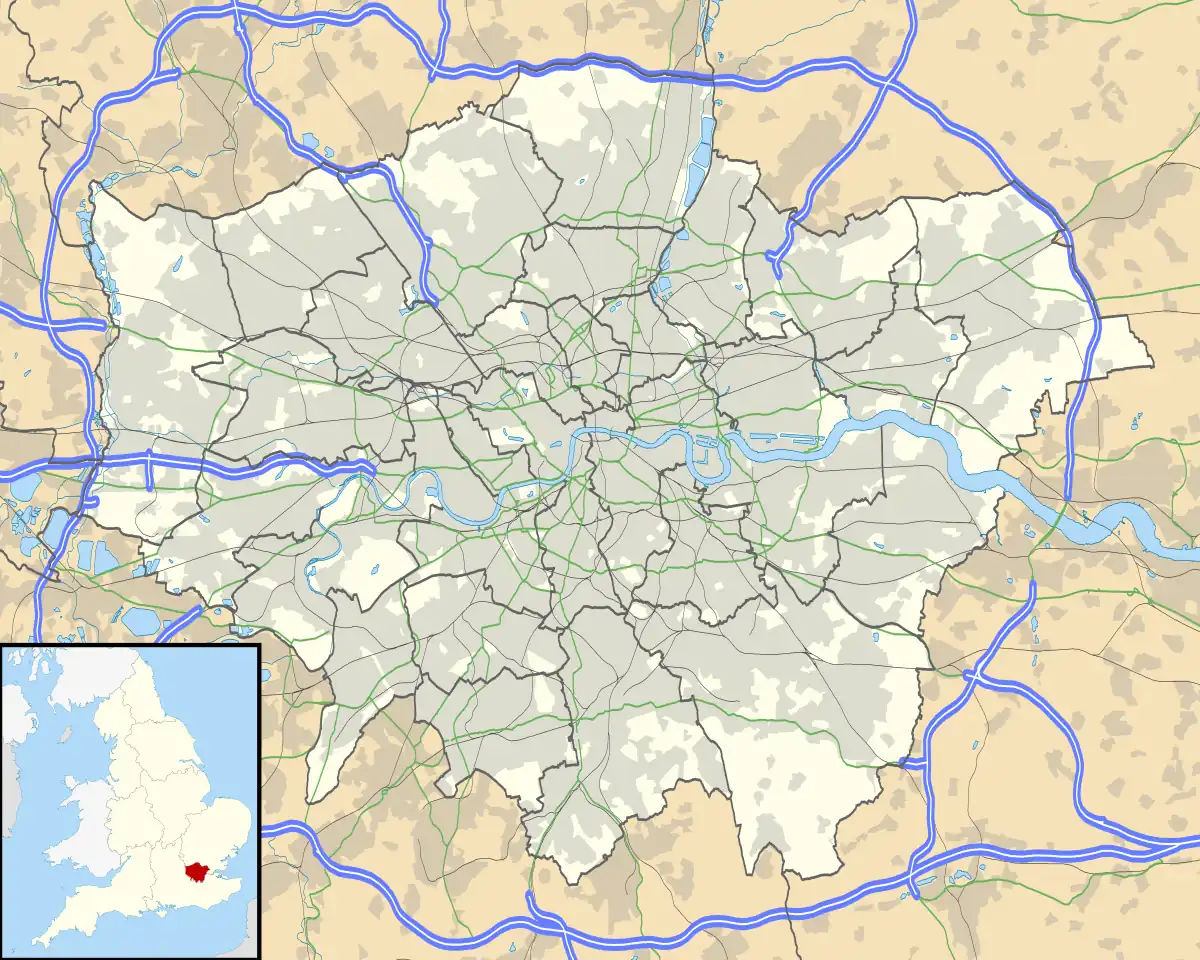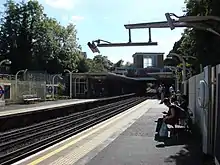| Eastcote | |
|---|---|
 | |
 Eastcote Location of Eastcote in Greater London | |
| Location | Eastcote |
| Local authority | London Borough of Hillingdon |
| Managed by | London Underground |
| Number of platforms | 2 |
| Fare zone | 5 |
| London Underground annual entry and exit | |
| 2018 | |
| 2019 | |
| 2020 | |
| 2021 | |
| 2022 | |
| Key dates | |
| 4 July 1904 | Tracks laid (Metropolitan) |
| 26 May 1906 | Opened (Metropolitan) |
| 1 March 1910 | Start (District) |
| 23 October 1933 | End (District) |
| 23 October 1933 | Start (Piccadilly) |
| 10 August 1964 | Goods yard closed[6] |
| Listed status | |
| Listing grade | II |
| Entry number | 1358405[7] |
| Added to list | 17 May 1994 |
| Other information | |
| External links | |
| WGS84 | 51°34′36″N 0°23′49″W / 51.57667°N 0.39694°W |
Eastcote is a London Underground station in Eastcote in the west of Greater London. The station is on the Uxbridge branch of both the Metropolitan line and Piccadilly line, between Rayners Lane and Ruislip Manor stations. The station is located on Field End Road. It is in Travelcard Zone 5.
History

The Metropolitan Railway (Harrow and Uxbridge Railway) constructed the line between Harrow-on-the-Hill and Uxbridge and commenced services on 4 July 1904 with, initially, Ruislip being the only intermediate stop. At first, services were operated by steam trains, but track electrification was completed in the subsequent months and electric trains began operating on 1 January 1905.
Progressive development in the north Middlesex area over the next two decades led to the gradual opening of additional stations along the Uxbridge branch to encourage the growth of new residential areas. Eastcote opened on 26 May 1906 as Eastcote Halt.[8]
On 1 March 1910, an extension of the District line from South Harrow to connect with the Metropolitan Railway at Rayners Lane was opened enabling District line trains to serve stations between Rayners Lane and Uxbridge from that date. On 23 October 1933 District line services were replaced by Piccadilly line trains. The station was rebuilt between 1937 and 1939[9] to a design by Charles Holden which features the large cube-shaped brick and glass ticket hall capped with a flat reinforced concrete roof and geometrical forms typical of the new stations built in this period. The station buildings and platforms are Grade II listed.[7]
The station is surrounded by the suburb of Eastcote; the original centre, now known as Old Eastcote is some distance away. The Cavendish Pavilion nearby was a popular destination for outings in the first part of the twentieth century.
Services
Metropolitan line
The Metropolitan line is the only line to operate an express service, though currently for Metropolitan line trains on the Uxbridge branch this is eastbound only in the morning peaks (06:30 to 09:30) Monday to Friday.[10]
The off-peak service in trains per hour (tph) is:[10]
- 8tph Eastbound to Aldgate via Baker Street (all stations)
- 8tph Westbound to Uxbridge
The morning peak service in trains per hour (tph) is:[10]
- 2tph Eastbound to Aldgate via Baker Street (semi-fast)
- 4tph Eastbound to Aldgate via Baker Street (all stations)
- 4tph Eastbound to Baker Street (all stations)
- 10tph Westbound to Uxbridge
The evening peak service in trains per hour (tph) is:[10]
- 7tph Eastbound to Aldgate via Baker Street (all stations)
- 3tph Eastbound to Baker Street (all stations)
- 10tph Westbound to Uxbridge
Piccadilly line
Between Rayners Lane and Uxbridge there is no Piccadilly Line service before approximately 06:30 (Monday - Friday) and 08:45 (Saturday - Sunday), except for one early morning departure from Uxbridge at 05:18 (Monday - Saturday) and 06:46 (Sunday).[11]
The off-peak service in trains per hour (tph) is:[11]
- 3tph Eastbound to Cockfosters
- 3tph Westbound to Uxbridge
The peak time service in trains per hour (tph) is:[11]
- 6tph Eastbound to Cockfosters
- 6tph Westbound to Uxbridge
Connections
London Buses routes 282 and 398 serve the station.
References
- ↑ "Station Usage Data" (CSV). Usage Statistics for London Stations, 2018. Transport for London. 23 September 2020. Archived from the original on 14 January 2023. Retrieved 11 October 2023.
- ↑ "Station Usage Data" (XLSX). Usage Statistics for London Stations, 2019. Transport for London. 23 September 2020. Archived from the original on 9 November 2020. Retrieved 9 November 2020.
- ↑ "Station Usage Data" (XLSX). Usage Statistics for London Stations, 2020. Transport for London. 16 April 2021. Retrieved 1 January 2022.
- ↑ "Station Usage Data" (XLSX). Usage Statistics for London Stations, 2021. Transport for London. 12 July 2022. Retrieved 7 September 2022.
- ↑ "Station Usage Data" (XLSX). Usage Statistics for London Stations, 2022. Transport for London. 4 October 2023. Retrieved 10 October 2023.
- ↑ Hardy, Brian, ed. (March 2011). "How it used to be – freight on The Underground 50 years ago". Underground News. London Underground Railway Society (591): 175–183. ISSN 0306-8617.
- 1 2 Historic England. "Eastcote London Regional Transport station, including adjacent shops and platforms (1357435)". National Heritage List for England. Retrieved 27 July 2016.
- ↑ Bowlt, Eileen. M (1989). 'The Goodliest Place in Middlesex'. A history of the Ancient Parish of Ruislip from the Domesday Book to modern times. Uxbridge: London Borough of Hillingdon. ISBN 0-907869-11-4.
- ↑ Lawrence, David (2008). Bright Underground Spaces. London: Capital Transport. p. 182.
- 1 2 3 4 "CULG - Metropolitan Line". davros.org.
- 1 2 3 "Archived copy" (PDF). Archived from the original (PDF) on 1 July 2016. Retrieved 31 May 2016.
{{cite web}}: CS1 maint: archived copy as title (link)
External links
- "Eastcote station". Tube departure boards. Transport for London.
- London Transport Museum Photographic Archive
- Eastcote Halt station, 1906
- Eastcote station, 1925 A group of children from the East End of London wait for a train to take them home from an excursion to the Pavilion.
- Eastcote station, 1933
- The Pavilion, 1933
- Eastcote station, 1949
- Eastcote station, 2001
| Preceding station | Following station | |||
|---|---|---|---|---|
| Ruislip Manor towards Uxbridge |
Metropolitan line Uxbridge branch |
Rayners Lane towards Baker Street or Aldgate | ||
| Piccadilly line | Rayners Lane towards Cockfosters or Arnos Grove | |||
| Former services | ||||
| Preceding station | Following station | |||
| Ruislip Manor towards Uxbridge |
District line (1910–1933) |
Rayners Lane towards Upminster | ||